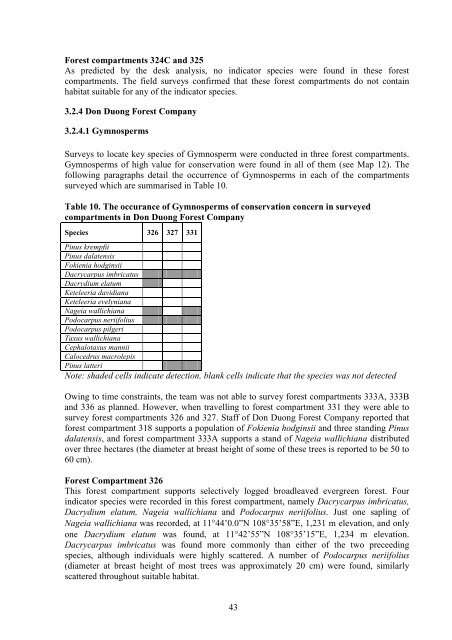a.TFF_rpt_on identification-planning - HCV Resource Network
a.TFF_rpt_on identification-planning - HCV Resource Network
a.TFF_rpt_on identification-planning - HCV Resource Network
You also want an ePaper? Increase the reach of your titles
YUMPU automatically turns print PDFs into web optimized ePapers that Google loves.
Forest compartments 324C and 325<br />
As predicted by the desk analysis, no indicator species were found in these forest<br />
compartments. The field surveys c<strong>on</strong>firmed that these forest compartments do not c<strong>on</strong>tain<br />
habitat suitable for any of the indicator species.<br />
3.2.4 D<strong>on</strong> Du<strong>on</strong>g Forest Company<br />
3.2.4.1 Gymnosperms<br />
Surveys to locate key species of Gymnosperm were c<strong>on</strong>ducted in three forest compartments.<br />
Gymnosperms of high value for c<strong>on</strong>servati<strong>on</strong> were found in all of them (see Map 12). The<br />
following paragraphs detail the occurrence of Gymnosperms in each of the compartments<br />
surveyed which are summarised in Table 10.<br />
Table 10. The occurance of Gymnosperms of c<strong>on</strong>servati<strong>on</strong> c<strong>on</strong>cern in surveyed<br />
compartments in D<strong>on</strong> Du<strong>on</strong>g Forest Company<br />
Species 326 327 331<br />
Pinus krempfii<br />
Pinus dalatensis<br />
Fokienia hodginsii<br />
Dacrycarpus imbricatus<br />
Dacrydium elatum<br />
Keteleeria davidiana<br />
Keteleeria evelyniana<br />
Nageia wallichiana<br />
Podocarpus neriifolius<br />
Podocarpus pilgeri<br />
Taxus wallichiana<br />
Cephalotaxus mannii<br />
Calocedrus macrolepis<br />
Pinus latteri<br />
Note: shaded cells indicate detecti<strong>on</strong>, blank cells indicate that the species was not detected<br />
Owing to time c<strong>on</strong>straints, the team was not able to survey forest compartments 333A, 333B<br />
and 336 as planned. However, when travelling to forest compartment 331 they were able to<br />
survey forest compartments 326 and 327. Staff of D<strong>on</strong> Du<strong>on</strong>g Forest Company reported that<br />
forest compartment 318 supports a populati<strong>on</strong> of Fokienia hodginsii and three standing Pinus<br />
dalatensis, and forest compartment 333A supports a stand of Nageia wallichiana distributed<br />
over three hectares (the diameter at breast height of some of these trees is reported to be 50 to<br />
60 cm).<br />
Forest Compartment 326<br />
This forest compartment supports selectively logged broadleaved evergreen forest. Four<br />
indicator species were recorded in this forest compartment, namely Dacrycarpus imbricatus,<br />
Dacrydium elatum, Nageia wallichiana and Podocarpus neriifolius. Just <strong>on</strong>e sapling of<br />
Nageia wallichiana was recorded, at 11°44’0.0”N 108°35’58”E, 1,231 m elevati<strong>on</strong>, and <strong>on</strong>ly<br />
<strong>on</strong>e Dacrydium elatum was found, at 11°42’55”N 108°35’15”E, 1,234 m elevati<strong>on</strong>.<br />
Dacrycarpus imbricatus was found more comm<strong>on</strong>ly than either of the two preceeding<br />
species, although individuals were highly scattered. A number of Podocarpus neriifolius<br />
(diameter at breast height of most trees was approximately 20 cm) were found, similarly<br />
scattered throughout suitable habitat.<br />
43
















